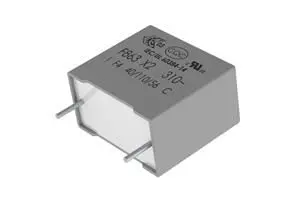source: Kemet news
F863 metallized polypropylene film capacitors provide robust, across-the-line filtering in automotive, industrial and mains-connected applications
GREENVILLE, S.C., Feb. 06, 2018 (GLOBE NEWSWIRE) — KEMET Corporation (NYSE:KEM), a leading global supplier of electronic components, today announced a new family of automotive grade metallized polypropylene film capacitors. F863 class X2 miniature capacitors are specifically designed to provide robust performance in safety applications in harsh environments and severe ambient conditions.
These new devices address applications in both the automotive and industrial segments. They provide across-the-line EMI and RFI filtering for the growing number of vehicle electronics applications, as well as in mains-connected indoor applications such as capacitive power supplies.
The F863 series meets AEC-Q200 qualification requirements and is available in capacitance values ranging from 0.1 microfarads to 10 microfarads with rated voltages up to 310 VAC. The new, fully approved RFI X2 capacitors have an operating temperature range of -40 to +110 degrees Celsius.
The metallized polypropylene film dielectric exhibits excellent self-healing characteristics. Additionally, KEMET’s designers have enhanced the major components of this capacitor series to help resist traditional capacitance-loss mechanisms. With these improvements, the F863 series offers very high capacitance stability while meeting ENEC, CUL and CQC international safety requirements.
“The number and severity of challenging electrical and environmental applications is rising,” said Fabio Scagliarini, KEMET Vice President of Film Development. “The demand for complex vehicle electronics is increasing, and customers expect sensitive electronics products to work safely and reliably in high temperature, high humidity situations. Devices from KEMET’s F863 series can provide our customers a robust, dependable solution in these scenarios and comply with the prevailing industry standards.”































